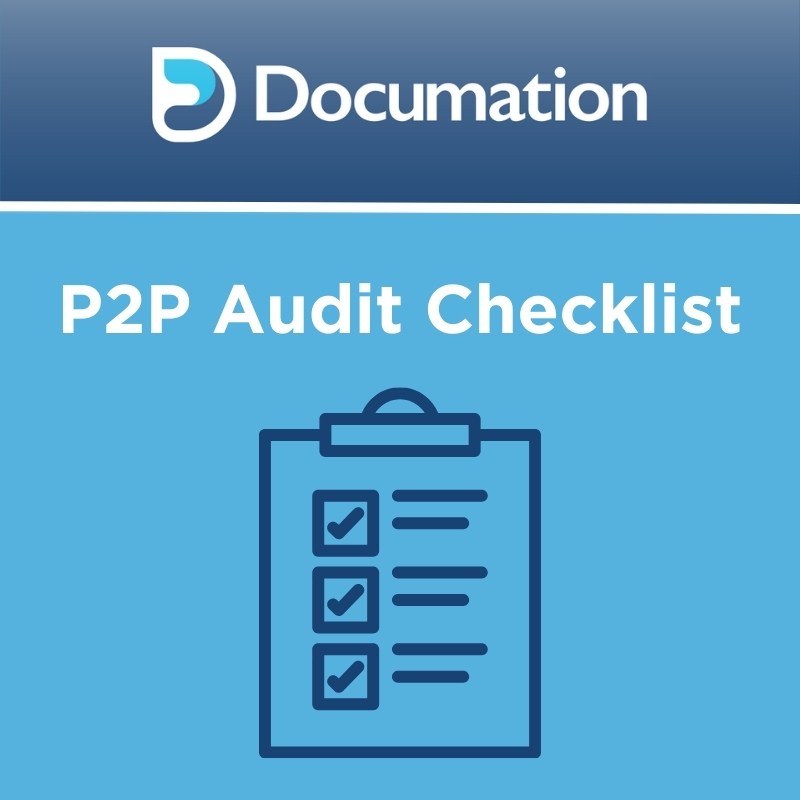Documation’s P2P Audit Checklist
Welcome to our Procure-to-Pay (P2P) audit checklist. Organisations are increasingly reliant on efficient procurement processes to streamline operations and enhance financial performance. The Procure-to-Pay cycle, encompassing everything from requisitioning to payment, plays a pivotal role in ensuring smooth and compliant transactions.
An effective P2P process not only optimises resource utilisation but also mitigates risks associated with fraud, errors, and non-compliance. Conducting regular audits of your P2P activities is essential to identify areas of improvement, strengthen internal controls, and safeguard organisational assets.
This comprehensive audit checklist is designed to assist auditors and stakeholders in evaluating the effectiveness and integrity of the Procure-to-Pay process. By systematically reviewing key components such as procurement policies, vendor management, invoice processing, and payment controls, this checklist aims to uncover potential vulnerabilities and promote best practices.
This checklist provides a structured framework to assess the robustness of your organisation’s procurement practices. By leveraging the insights gained from this audit, organisations can optimise their P2P processes, improve transparency and visibility, and bolster their overall financial integrity.
What is a P2P Audit?
A P2P audit, or Procure-to-Pay audit, is an examination of the entire procurement process within an organisation, from the initial requisition of goods or services to the final payment to vendors. The primary objective of a P2P audit is to assess the efficiency, effectiveness, and integrity of the procurement process, ensuring compliance with internal policies, regulatory requirements, and industry standards.
What are the Stages of a P2P Audit
The stages and procedures of conducting a P2P audit typically involve the following steps.
1. Preparation and Planning
- Define the audit objectives, scope, and criteria.
- Establish the audit team and allocate responsibilities.
- Review relevant policies, procedures, and regulations governing the P2P process.
- Develop an audit plan outlining the approach, key activities, timelines, and resource requirements.
2. Risk Assessment
- Identify and prioritise potential risks associated with the P2P process, such as fraud, errors, non-compliance, and inefficiencies.
- Assess the significance and likelihood of identified risks to prioritise audit focus areas.
- Consider factors such as transaction volume, value, complexity, and regulatory requirements.
3. Data Collection
- Gather documentation and evidence related to P2P transactions, including procurement policies, contracts, purchase orders, invoices, receipts, and payment records.
- Obtain access to relevant systems and databases to extract transactional data for analysis.
- Conduct interviews with key stakeholders involved in the P2P process to understand workflows, controls, and potential areas of risk.
4. Testing and Analysis
- Perform substantive testing of P2P transactions to assess compliance with policies, procedures, and regulatory requirements.
- Verify the accuracy, completeness, and authorisation of transactions, including requisitions, purchase orders, receipts, invoices, and payments.
- Analyse transactional data for anomalies, patterns, and trends that may indicate control deficiencies, fraud, or non-compliance.
5. Control Evaluation
- Evaluate the design and effectiveness of internal controls within the P2P process, such as segregation of duties, authorisation controls, and documentation requirements.
- Identify control deficiencies, weaknesses, or gaps that could lead to errors, fraud, or non-compliance.
- Consider control environment factors, such as management oversight and organisational culture.
6. Findings and Recommendations
- Document audit findings, including control deficiencies, compliance issues, and operational inefficiencies.
- Assess the significance and potential impact of audit findings on the organisation’s objectives, financial integrity, and reputation.
- Develop practical recommendations for addressing identified issues, strengthening controls, and improving the efficiency and effectiveness of the P2P process.
7. Reporting
- Prepare an audit report summarising the objectives, scope, methodology, findings, and recommendations of the audit.
- Clearly communicate audit results to relevant stakeholders, including management, audit committees, and regulatory authorities.
- Obtain management’s response to audit findings and proposed recommendations.
8. Follow-up and Monitoring
- Monitor the implementation of audit recommendations and management’s corrective actions to address identified issues.
- Track the effectiveness of remedial measures in improving control deficiencies and mitigating risks.
- Conduct follow-up audits or reviews as necessary to verify the resolution of audit findings and ensure sustained compliance with policies and regulations.

The Importance and Purpose of a Complete P2P Audit
A complete Procure-to-Pay (P2P) audit and process is vital for identifying inefficiencies, ensuring compliance, and mitigating risks within the procurement process. It thoroughly evaluates the end-to-end process from procurement of goods and services to payment, highlighting areas for cost savings, streamlining operations, and enhancing supplier relationships.
Risk Mitigation
By thoroughly examining each stage of the procurement process, a P2P audit helps identify and mitigate risks related to fraud, errors, non-compliance with policies and regulations, vendor management issues, and inefficient processes.
Financial Integrity
Auditing the entire P2P cycle ensures that financial transactions are accurately recorded, properly authorised, and compliant with internal controls and regulatory requirements. This helps maintain the integrity of financial statements.
Operational Efficiency
Assessing P2P processes enables organisations to identify areas of inefficiency, such as bottlenecks, delays, and redundant activities. By optimising these processes, organisations can streamline operations, reduce costs, and improve productivity.
Compliance Assurance
A P2P audit ensures that procurement activities adhere to relevant laws, regulations, and organisational policies. This is crucial for organisations operating in regulated industries or those subject to compliance standards such as Sarbanes-Oxley (SOX), GDPR, or industry-specific regulations.
Vendor Management
Evaluating vendor selection, onboarding, and management practices during a P2P audit helps ensure that organisations engage with reputable vendors, negotiate favourable terms, and maintain effective supplier relationships, ultimately reducing the risk of supply chain disruptions.
Internal Control Assessment
P2P audits assess the effectiveness of internal controls designed to safeguard assets, prevent and detect errors or irregularities, and ensure compliance with organisational policies and procedures. Identifying control deficiencies allows organisations to strengthen their control environment and reduce the likelihood of material misstatements or fraud.
Stakeholder Confidence
Conducting regular P2P audits demonstrates a commitment to transparency, accountability, and sound governance practices. It enhances stakeholders’ confidence in the organisation’s financial reporting, risk management, and operational effectiveness, fostering trust among investors, customers, regulators, and other stakeholders.
Continuous Improvement
The insights gained from a P2P audit enable organisations to implement corrective actions, enhance processes, and strengthen controls continuously. By addressing weaknesses identified through audits, organisations can drive continuous improvement and adapt to changing business environments effectively.
How Automation Can Help P2P Audits
Automation can significantly improve P2P audits by streamlining processes, improving accuracy, and increasing efficiency.
Data Extraction and Analysis
Automation P2P tools, such as intelligent capture, can extract data from various sources such as ERP systems, procurement software, and electronic documents. This accelerates the audit process by providing auditors with access to large volumes of transactional data in a structured format, enabling efficient analysis and identification of anomalies.
Continuous Monitoring
Automated monitoring systems can continuously monitor P2P transactions in real-time, flagging suspicious activities, deviations from policies, and potential control weaknesses. This proactive approach enables auditors to detect issues promptly and take corrective action before they escalate.
Rule-Based Testing
Automation allows auditors to apply predefined rules and algorithms to analyse P2P transactions systematically. By automating rule-based testing procedures, auditors can quickly identify deviations from expected norms, such as duplicate payments, unauthorised purchases, or deviations from pricing agreements.
Workflow Automation
Automating P2P workflows streamlines the entire procurement process, from requisition to payment. Workflow automation ensures that each step in the process is executed consistently and efficiently, reducing manual errors and delays. Auditors can leverage workflow automation to assess the effectiveness of controls and identify opportunities for optimisation.
Exception Handling
Automation tools can handle routine tasks and exception handling processes, such as invoice matching, discrepancy resolution, and approval workflows. By automating these tasks, auditors can focus on more strategic activities, such as data analysis, risk assessment, and control evaluation.
Audit Trail Generation
Automated and Ai systems generate comprehensive audit trails that capture every step in the P2P process, including user actions, approvals, and system activities. These audit trails provide auditors with a detailed record of transactional history, enabling them to trace the flow of transactions and identify potential control issues or audit trail gaps.
Reporting and Documentation
Automation facilitates the generation of standardised audit reports and documentation, ensuring consistency and accuracy in reporting. Automated reporting tools can compile audit findings, recommendations, and supporting evidence into professional reports, enhancing communication with stakeholders and management.
Integration with Analytics Tools
Automation tools can integrate with data analytics and visualisation tools, such as power BI, to perform advanced data analysis and identify trends, patterns, and outliers in P2P transactions. By leveraging analytics, auditors can gain deeper insights into procurement processes, risks, and opportunities for improvement.
Summary
By conducting a P2P audit, organisations can identify areas of weaknesses, inefficiencies, and compliance risks within their procurement process. The findings from the audit can be used to implement corrective actions, strengthen internal controls, and improve overall operational effectiveness and financial integrity. Additionally, P2P audits help organisations demonstrate accountability to stakeholders and regulators, enhance trust with vendors, and optimise resource utilisation.





